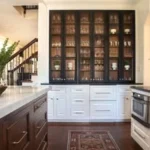Cabinet Wood Species
Traditionally cabinets have been constructed from a wide variety of wood species. Over time cabinetmakers have narrowed the field to those woods that are widely available (lower cost) with traits that stand up to the wear & tear, and provide desirable looks when painted or stained. The most common cabinet wood species used in solid wood cabinet construction today are oak, maple, alder, cherry, or an MDF with a wood veneer.
What is important when choosing the type of wood for your cabinets?
PRICE
Unless you are considering extremely rare or exotic wood selections, the choice of wood species has a modest impact (10-20% variation) on the overall cost of the cabinet.
LOOK
Because of the variation in grains, colors, and natural characteristics like knots, bird pecks, mineral streaks, etc. the selection of wood species has a tremendous impact on the look of your kitchen especially if you are planning to stain your cabinets.
DURABILITY
Especially important for families, woods vary widely in "hardness." Some softer woods like pine & alder mar and dent much easier than harder woods like maple, oak, cherry, and walnut.
MELLOWING
Over time with exposure to sunlight woods "mellow" or change color to some degree. Some woods lighten a couple of shades in the first 6 months in your home while other woods darken a couple shades.
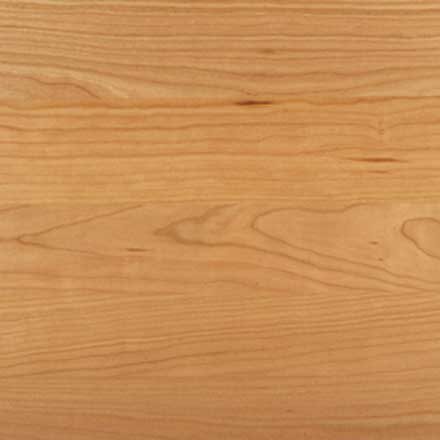
Cherry
Cherry is a smooth hardwood with a fairly uniform grain known for its rich character which brings a sense of warmth to interiors.
Mostly ranging in color from light to deep reddish brown, Cherry cabinet wood may have areas that are yellowish, green, and even gray.
Cherry's heartwood varies from deep red to a reddish-brown hue.
With age and exposure to natural light, the colors will mellow, turning the darker areas of the wood a dark, reddish brown while the lighter areas darken to shades of yellow and brown.
Although softer than some of the other hardwoods, cherry is still hard enough to withstand knocks and marring.
Cherry tends to fall at the higher end of the wood species price range for cabinets.
Designer Tips
- Cherry is a very popular choice because of its versatility. It is beautiful in its elegance and formality when used for certain traditional styles, and can also give a kitchen a warm, contemporary personality.
- Almost any finish looks great on cherry as it takes stain evenly. Cherry is known for mid and darker tones, but lighter stain colors also look fantastic on Cherry.

Alder Wood
Alder Wood is a reasonably straight-grained hardwood with a uniform texture providing the often desired trait of color stability.
This medium density hardwood features a color range of light browns with reddish or peach hues.
Natural characteristics of Alder include small sound knots, periodic curly grain patterns, pin holes, and mineral streaks.
Moderately lightweight and considerably softer than other hardwood species, Alder resists wearing less effectively than Maple, Cherry or Oak.
Alder like Cherry tends to darken a couple shades as it mellows with exposure to sunlight.
Alder has very similar visual characteristics as Cherry for a lower price point. Along with Maple, Alder resides in the middle of the wood species price range for cabinets.
Designer Tips
- Combining distressing and glazing options works well to give a rustic environmentally conditioned look with the glaze hanging in the distressed areas.
- Extra care should be taken because Alder can dent and mar more easily than other hardwoods.
- If you don't want to pay for Cherry, Alder is a great choice ... it is sometimes referred to as the "Poor Man's Cherry".

Hickory
Hickory has an easily recognizable look of prominent grain patterns and dramatic color variations ranging from light creams to dark browns that occur within the same panel.
Characteristic depressions, mineral streaks, and random knots are naturally occurring in Hickory.
Hickory is a dense wood with closed and open wood grain, which enhances the color variations when this creamy, pale yellow wood is stained.
Although a bit lighter, Hickory is similar in grain pattern and strength to Oak resisting wear very well.
With time and exposure to sunlight, Hickory mellows by darkening a couple shades.
Hickory falls at the lower end of the wood species price range for cabinets.
Designer Tips
- Hickory's blonde tones are complemented nicely by a transparent or natural finish.
- Hickory's wild grain patterns and color variations make it a popular choice for rustic mountain or rural design styles.

Red Oak
Red Oak was the cabinet of choice in the 1970's through early 1990's and after a long departure is beginning to make a comeback with some of the glazing, and distressing options available today.
Oak has a prominent grain pattern that ranges from tight straight grain to wild wavy patterns and its distinctive "cathedral arch" type grain patterns.
Oak cabinets natural coloring can range from light creamy whites to light browns with pink or reddish hues.
Oak is strong, durable, and hearty wood that handles abuse well making it a good choice for families.
The open grain of Oak accepts stain evenly and reveals the natural beauty of the grain patterns and its variation of coloring especially with lighter finishes.
Like most of the cabinet hardwoods, Oak mellows by darkening a couple shades.
Similar to Hickory, Oak falls at the lower end of the wood species price range for cabinets.
Designer Tip
- Although not as popular as it once was, Oak's durability, uniform coloring & grain patterns, and its affordability make it a wood species worth considering.
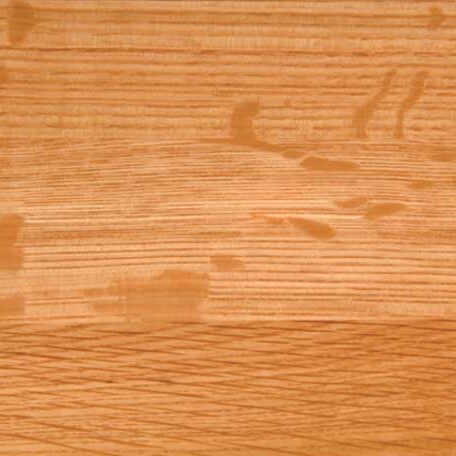
Quarter Sawn Red Oak
Quarter Sawn Red Oak carries the same characteristics of Oak as listed above. The primary difference is the unique look produced by altering the manner in which the wood planks are "sawn" from the log.
Unique grain patterns are created by quartering the log then cutting the quarter using the heart as the edge rather than the center.
This process produces a distinctive and desirable straight grain pattern with an intriguing “fleck” that appears randomly across the grain of the wood.
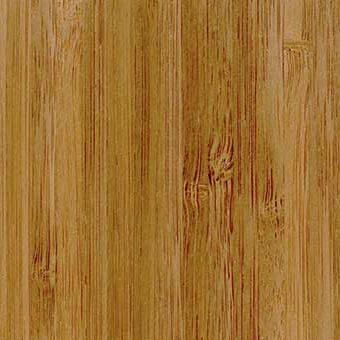
Bamboo
Bamboo: has many similar characteristics to hardwoods, but bamboo is species of grass as opposed to a wood species.
Bamboo's natural density produces a uniform wood grain with an extraordinarily even & consistent finish that is significantly harder than its hardwood cousins.
Produced through a pressure heating process, our Bamboo has a beautiful amber color.
An eco-friendly wood, bamboo accepts stains readily and has a unique appearance.
Bamboo is extremely hard and durable, which wears admirably in even the most raucous family environments.
Designer Tip
- Although Bamboo is a fairly popular choice for flooring, it has not caught on as readily for cabinets. So it carries a higher price tag similar to the exotic woods.
Engineered Exotic Wood Veneers
Developed to address the desire for grain & color consistency, engineered veneers have the added benefit of utilizing readily available sustainable wood species.
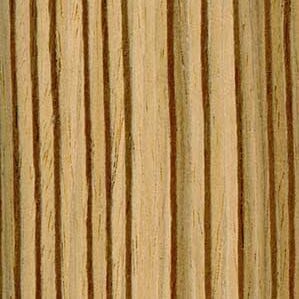
Zebrawood
A veneer created to simulate the exotic look of quarter sawn Zebrawood of Equatorial Africa. The grain pattern has golden-yellow heartwood with bold stripes ranging from dark brown to almost black providing the distinctive zebra striping. It has a smooth texture that wears well and will "mellow" by lightening with age and exposure to sunlight.
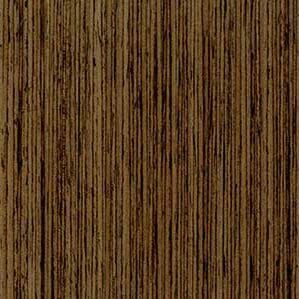
Wenge
A veneer created to simulate the exotic Wenge wood species from Central Africa. It's tight grain pattern consists of a warm brown hued heartwood with the distinctive dark veining of authentic Wenge. The vibrant coloring gives it a unique style unavailable in domestic wood species.
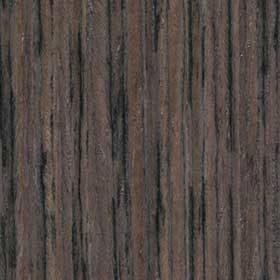
Shale
Shale is an exotic looking veneer that provides a consistent smooth texture combined with a unique medium brown-gray coloring streaked with straight black grain. Shale "mellows' by lightening slightly with age and exposure to sunlight. This engineered veneer stands up to wear very well.

MDF - Medium Density Fiberboard
MDF (Medium Density Fiberboard) While not strictly a wood species, MDF, is so prevalent in "cabinetmaking" it is important to at least mention.
MDF is produced by breaking down wood residuals into wood fibers which are then exposed to heat and pressure to form a fiberboard.
Even with extreme changes in humidity and temperature, MDF doesn't warp or crack.
Made from very fine wood particles, MDF has less variability than wood and no noticeable grain which provides a smoother finish, especially when painted.
Depending on the finish, MDF gets easily scratched and cannot be repaired, unlike wood that can be sanded and repainted or stained.
MDF's core materials can be irreparably damaged if exposed to extreme heat.


